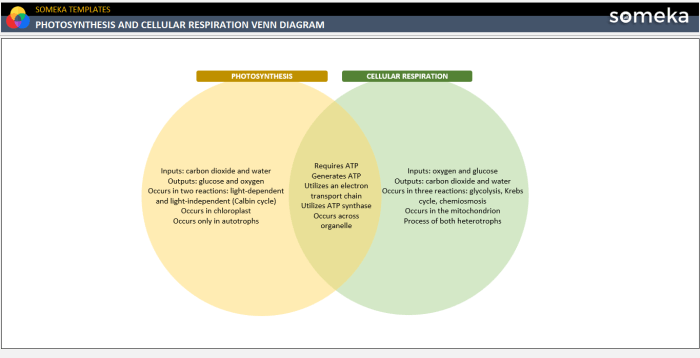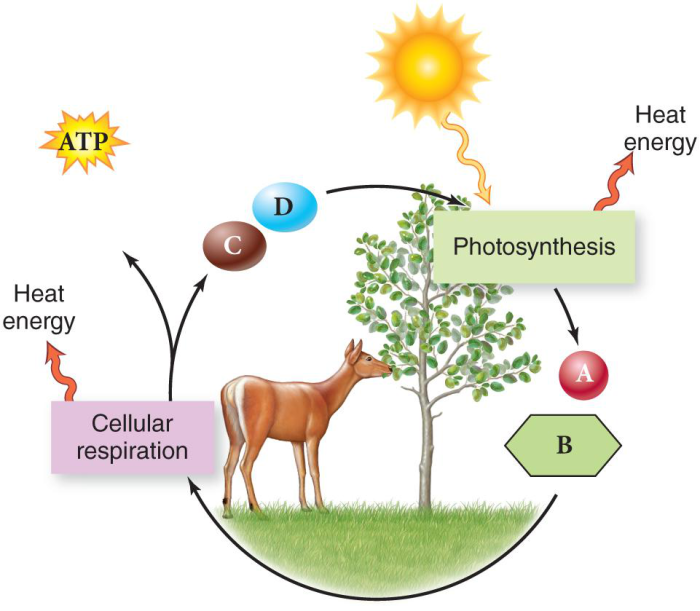Photosynthesis and respiration venn diagram – Delving into the intricate relationship between photosynthesis and respiration, this article unveils the significance of these processes through a comprehensive Venn diagram analysis. This visual representation illuminates the shared and distinct characteristics of these fundamental life-sustaining reactions, shedding light on their crucial roles in the intricate web of life.
Photosynthesis vs. Respiration: Photosynthesis And Respiration Venn Diagram

Photosynthesis and respiration are two fundamental processes that sustain life on Earth. Photosynthesis is the process by which plants and other organisms use sunlight to convert carbon dioxide and water into glucose and oxygen. Respiration, on the other hand, is the process by which organisms break down glucose to release energy.
There are several key differences between photosynthesis and respiration. Photosynthesis is an anabolic process, meaning that it builds up complex molecules from simpler ones. Respiration, on the other hand, is a catabolic process, meaning that it breaks down complex molecules into simpler ones.
Photosynthesis occurs in the chloroplasts of plant cells, while respiration occurs in the mitochondria of all cells.
Similarities and Differences
Despite their differences, photosynthesis and respiration share some similarities. Both processes involve the exchange of gases. Photosynthesis releases oxygen into the atmosphere, while respiration consumes oxygen and releases carbon dioxide. Both processes also involve the transfer of energy. Photosynthesis converts light energy into chemical energy, while respiration converts chemical energy into ATP.
The following Venn diagram illustrates the similarities and differences between photosynthesis and respiration:
- Similarities:
- Exchange of gases
- Transfer of energy
- Differences:
- Photosynthesis is anabolic, while respiration is catabolic
- Photosynthesis occurs in chloroplasts, while respiration occurs in mitochondria
Energy Conversion
Energy conversion is a key aspect of both photosynthesis and respiration. In photosynthesis, light energy is converted into chemical energy stored in glucose. This energy is then used to power the cell’s activities. In respiration, chemical energy stored in glucose is converted into ATP.
ATP is the cell’s main energy currency, and it is used to power all of the cell’s activities.
Reactants and Products
The reactants and products of photosynthesis and respiration are as follows:
- Photosynthesis:
- Reactants: Carbon dioxide, water, light energy
- Products: Glucose, oxygen
- Respiration:
- Reactants: Glucose, oxygen
- Products: Carbon dioxide, water, ATP
Environmental Implications
Photosynthesis and respiration have important environmental implications. Photosynthesis is responsible for producing the oxygen that we breathe. It also helps to remove carbon dioxide from the atmosphere. Respiration, on the other hand, releases carbon dioxide into the atmosphere. However, respiration is also essential for the cycling of carbon and oxygen in the atmosphere.
Cellular Respiration, Photosynthesis and respiration venn diagram
Cellular respiration is a complex process that occurs in the mitochondria of all cells. It can be divided into three main stages:
- Glycolysis: This is the first stage of cellular respiration. It occurs in the cytoplasm of the cell and involves the breakdown of glucose into two molecules of pyruvate.
- Krebs cycle: This is the second stage of cellular respiration. It occurs in the mitochondria and involves the further breakdown of pyruvate into carbon dioxide and water. This process also generates ATP.
- Electron transport chain: This is the final stage of cellular respiration. It occurs in the mitochondria and involves the transfer of electrons from NADH and FADH2 to oxygen. This process generates most of the ATP produced during cellular respiration.
Importance in Life Processes
Photosynthesis and respiration are essential for life on Earth. Photosynthesis provides the food and oxygen that all organisms need to survive. Respiration provides the energy that all organisms need to power their activities. Without photosynthesis and respiration, life on Earth would not be possible.
Question Bank
What is the primary difference between photosynthesis and respiration?
Photosynthesis utilizes light energy to convert carbon dioxide and water into glucose, releasing oxygen as a byproduct, while respiration utilizes oxygen to break down glucose, releasing energy and producing carbon dioxide and water.
How does the Venn diagram illustrate the similarities between photosynthesis and respiration?
The overlapping area of the Venn diagram represents the shared requirement for water and the release of carbon dioxide, highlighting their interconnectedness in the cycling of these essential elements.
What is the significance of the non-overlapping areas in the Venn diagram?
The non-overlapping areas emphasize the unique characteristics of each process, such as the utilization of light energy in photosynthesis and the consumption of oxygen in respiration, showcasing their distinct roles in energy metabolism.

